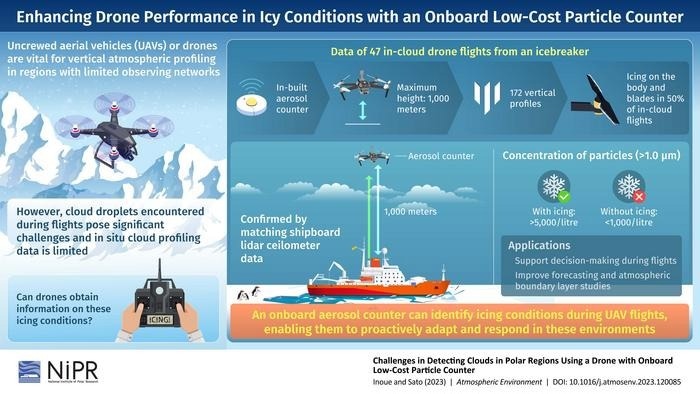Accurate meteorological data collection can be particularly difficult in distant and tough areas such as the polar regions and mountains. These places frequently lack the infrastructure and resources required for regular weather stations, and the extreme weather conditions can make accessing and maintaining these stations difficult.

An onboard aerosol counter can identify icing conditions during drone flights, enabling them to adapt and respond in these extreme environments. Image Credit: Jun Inoue from National Institute of Polar Research, Japan
Drones can travel these difficult terrains, collect data, and communicate it to researchers, making them an essential tool for filling data gaps. Unfortunately, in-cloud flights continue to be problematic, with ice from supercooled cloud droplets damaging crucial drone components and making them unusable.
Dr. Jun Inoue and Dr. Kazutoshi Sato of Japan’s National Institute of Polar Research collaborated to design a novel solution: they installed onboard aerosol counters into a series of drones utilized during the Japanese Antarctic Research Expedition 2022/2023.
The study was released online on September 16th, 2023, and will be published in Volume 314 of Atmospheric Environment on December 1st, 2023. Aerosol counters, which are generally used to quantify the concentration of particles in the air, were utilized by scientists to identify the existence of clouds during drone flights.
Under usual conditions in our expedition, we typically observe concentrations of fewer than a thousand particles per liter. However, when we encounter icing conditions, we see concentrations of 5,000 particles per liter or even higher.
Dr. Jun Inoue, Associate Professor, National Institute of Polar Research
This modification allows drones to identify and respond to dangerous circumstances in real time.
The drones do not need to go far horizontally during meteorological vertical profiling, which entails the knowledge of atmospheric conditions at different altitudes, making it easier to select when to descend under icing circumstances. The aerosol counter is critical in this case because it allows drone operators to make educated judgments quickly.
The scientists matched the observations of the counters with data collected from a shipboard lidar ceilometer to further corroborate the method’s trustworthiness. The ceilometer gives crucial information regarding cloud features such as height and whether they are made of water or ice.
The authors investigated the attenuated backscatter coefficient, which indicates how light bounces off clouds and were able to establish a clear link between the increased particle counts discovered by the aerosol counter based on 47 in-cloud flights and the existence of supercooled liquid clouds.
Half of the in-cloud flights reached heights of around 1,000 meters above sea level, and the counters effectively detected icing conditions. This information assisted the drones in avoiding harmful icing situations.
Drones could be a helpful tool for researching the atmosphere, particularly in polar regions, and the results can help scientists better understand clouds and weather.
Journal Reference
Inoue, J., et al. (2023) Challenges in Detecting Clouds in Polar Regions Using a Drone with Onboard Low-Cost Particle Counter. Atmospheric Environment. doi:10.1016/j.atmosenv.2023.120085